
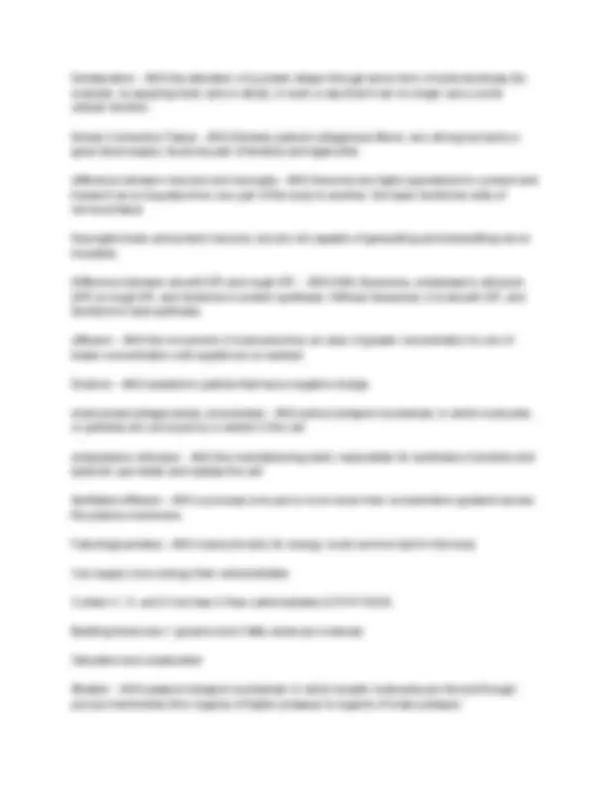
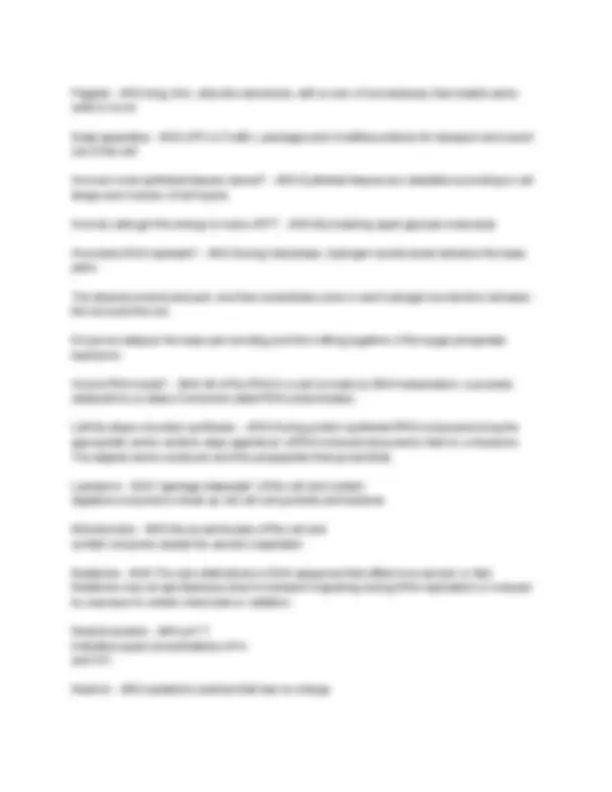
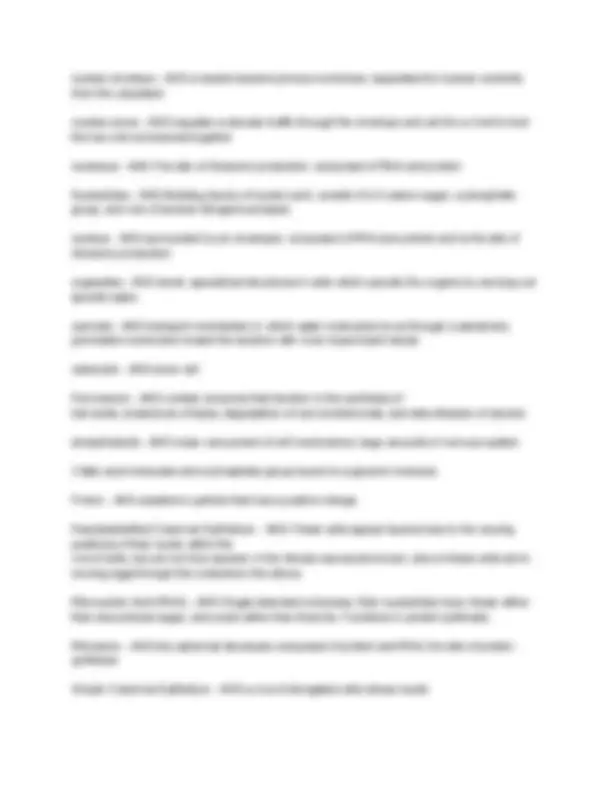
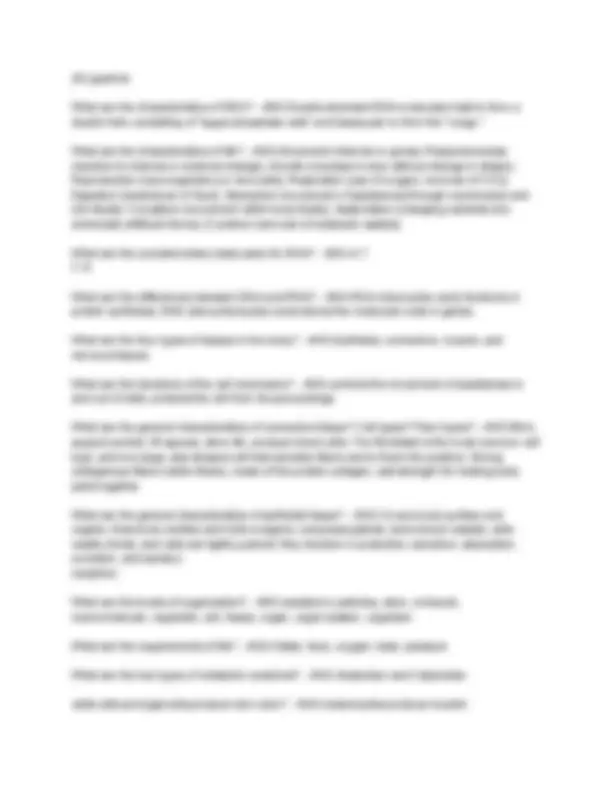

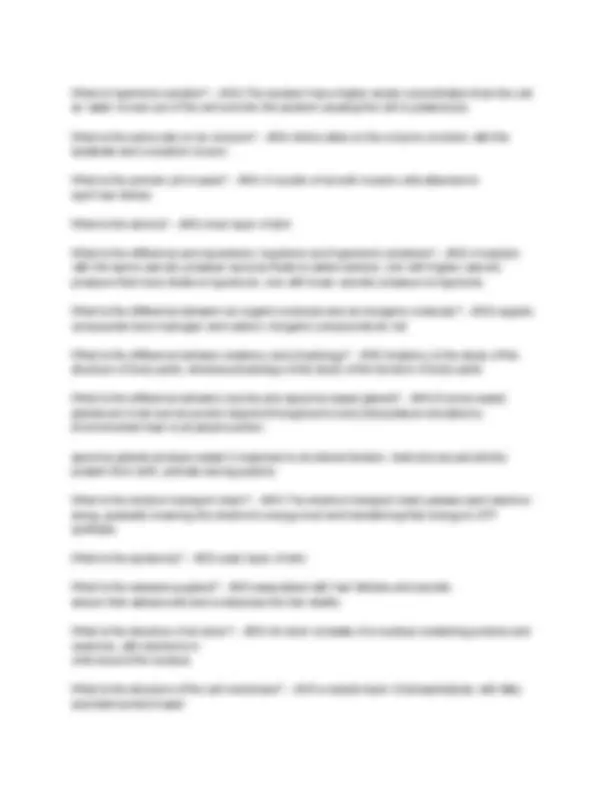


Study with the several resources on Docsity

Earn points by helping other students or get them with a premium plan


Prepare for your exams
Study with the several resources on Docsity

Earn points to download
Earn points by helping other students or get them with a premium plan
Community
Ask the community for help and clear up your study doubts
Discover the best universities in your country according to Docsity users
Free resources
Download our free guides on studying techniques, anxiety management strategies, and thesis advice from Docsity tutors
APHY 101 MIDTERM EXAM LATEST QUESTIONS AND CORRECT ANSWERS IVY TECH COMMUNITY COLLEGE INDIANAPOLIS
Typology: Exams
1 / 11

This page cannot be seen from the preview
Don't miss anything!







3 types of cartilage - ANS-Hyaline cartilage, elastic cartilage, fibrocartilage 3 types of muscle tissue - ANS-skeletal, smooth, and cardiac Acidic solution - ANS-pH less than 7; indicates a greater concentration of H+ active transport - ANS-a carrier molecule transports substances from regions of lower concentration to regions of higher concentration Adipose Tissue - ANS-connective tissue designed to store fat; it is found beneath the skin, around joints, padding the kidneys and other internal organs, and in certain abdominal membranes Anabolism - ANS-Small molecules are built up into larger molecules, requiring energy Atomic mass - ANS-number of protons plus number of neutrons Atomic nucleus - ANS-the nucleus contains protons and neutrons Atomic number - ANS-number or protons in nucleus Basic solution - ANS-pH greater than 7; indicates a greater concentration of OH- Canaliculi - ANS-small channels through matrix; necessary for nutrient and wast exchange cardiac muscle tissue - ANS-heart movements; involuntary Cartilage - ANS-rigid connective tissue that provides a supportive framework; lacks blood supply Catabolism - ANS-larger molecules are broken down into smaller molecules, releasing energy cell membrane - ANS-regulates the movement of substances in and out of the cell; participates in signal transduction; and helps cells adhere to other cells
Centrosome - ANS-structure made up of two hollow cylinders called centrioles that function in the separation of chromosomes during cell division chromatin - ANS-It condenses into chromosomes during cell division; it is made of protein and DNA Cilia - ANS-motile extensions from the cell codons - ANS-set of three nucleotides in a messenger RNA molecule corresponding to one of the 20 types of amino acids condrocyte - ANS-cartilage cell cytoplasm - ANS-consists of a clear liquid (cytosol), a supportive cytoskeleton, and networks of membranes and organelles cytosol - ANS-the liquid part of the cytoplasm in which various organelles are suspended Define amino acids - ANS-building block of proteins Define atoms - ANS-smallest particle of an element; basic unit of matter Define catalyst - ANS-influence the rates of chemical reactions Define decomposition reaction - ANS-Larger molecules are broken down into smaller ones Define element - ANS-fundamental substance composed of chemically identical atoms Define exchange reaction - ANS-Parts of molecules trade places Define homeostasis - ANS-Body's maintenance of a stable environment Define ion - ANS-When atoms gain or lose electrons, they become ions. Define matter - ANS-Anything that takes up space and has mass (weight). It is composed of elements. Define product - ANS-Substances formed at the end of the chemical reaction Define reactant - ANS-The starting materials of the reaction - the atoms, ions, or molecules Define synthesis reaction - ANS-Two or more atoms or molecules are joined together
Flagella - ANS-long, thin, whip-like structures, with a core of microtubules, that enable some cells to move Golgi apparatus - ANS-UPS or FedEx; packages and modifies proteins for transport and export out of the cell How are most epithelial tissues named? - ANS-Epithelial tissues are classified according to cell shape and number of cell layers How do cells get the energy to make ATP? - ANS-By breaking apart glucose molecules How does DNA replicate? - ANS-During interphase, hydrogen bonds break between the base pairs. The strands unwind and part, and free nucleotides come in and hydrogen bonds form between the new and the old. Enzymes catalyze the base pair bonding and the knitting together of the sugar-phosphate backbone. How is RNA made? - ANS-All of the RNA in a cell is made by DNA transcription, a process catalyzed by a class of enzymes called RNA polymerases. List the steps of protein synthesis. - ANS-During protein synthesis tRNA molecules bring the appropriate amino acids to align against an mRNA molecule temporarily held on a ribosome. The aligned amino acids join and the polypeptide that grows folds. Lysosome - ANS-"garbage disposals" of the cell and contain digestive enzymes to break up old cell components and bacteria Mitochondria - ANS-the powerhouses of the cell and contain enzymes needed for aerobic respiration Mutations - ANS-The rare distinctions in DNA sequence that affect how we look or feel. Mutations may be spontaneous (due to transient mispairing during DNA replication) or induced by exposure to certain chemicals or radiation. Neutral solution - ANS-pH 7; indicates equal concentrations of H+ and OH- Neutron - ANS-subatomic particle that has no charge
nuclear envelope - ANS-a double-layered porous membrane; separates the nuclear contents from the cytoplasm nuclear pores - ANS-regulate molecular traffic through the envelope and act like a rivet to hold the two unit membranes together nucleolus - ANS-The site of ribosome production; composed of RNA and protein Nucleotides - ANS-Building blocks of nucleic acid; consist of a 5-carbon sugar, a phosphate group, and one of several nitrogenous bases nucleus - ANS-surrounded by an enveloper; composed of RNA and protein and is the site of ribosome production organelles - ANS-small, specialized structures in cells which operate like organs by carrying out specific tasks osmosis - ANS-transport mechanism in which water molecules move through a selectively permeable membrane toward the solution with more impermeant solute osteocyte - ANS-bone cell Peroxisome - ANS-contain enzymes that function in the synthesis of bile acids, breakdown of lipids, degradation of rare biochemicals, and detoxification of alcohol phospholipids - ANS-major component of cell membranes; large amounts in nervous system 2 fatty acid molecules and a phosphate group bound to a glycerol molecule Proton - ANS-subatomic particle that has a positive charge Pseudostratified Columnar Epithelium - ANS-These cells appear layered due to the varying positions of their nuclei within the row of cells, but are not truly layered; in the female reproductive tract, cilia on these cells aid in moving eggs through the oviducts to the uterus Ribonucleic Acid (RNA) - ANS-Single-stranded molecules, their nucleotides have ribose rather than deoxyribose sugar, and uracil rather than thymine. Functions in protein synthesis. Ribosome - ANS-tiny spherical structures composed of protein and RNA; the site of protein synthesis Simple Columnar Epithelium - ANS-a row of elongated cells whose nuclei
transport mechanisms that are passive mechanisms - ANS-simple diffusion facilitated diffusion osmosis filtration Vesicle - ANS-small, membrane sacs that specialize in moving products into, out of, and within a cell What are carbohydrates? - ANS-Carbohydrates provide energy for cellular activities. These molecules contain carbon, hydrogen, and oxygen. What are covalent bonds? - ANS-Covalent bonds are formed when atoms share electrons to become stable with filled outer shells What are enzymes? - ANS-large molecules that increase the rates of chemical reactions without themselves undergoing any change What are hydrogen bonds? - ANS-Weak attraction between positive end of one polar molecule and negative end of another polar molecule; formed between water molecules What are ionic bonds? - ANS-2 oppositely charged atoms form this bond when electrons are transferred from one atom to another atom What are lipids? - ANS-Primarily used to supply energy for cellular activity. Lipids are insoluble in water and include fats, phospholipids, and steroids. What are nucleic acids? - ANS-Carry genes and control cell activities. Examples are RNA and DNA. What are proteins? - ANS-Provide structure; energy sources; chemical messengers Play vital role in metabolism bonded amino acids held together with peptide bonds What are the 4 types the DNA molecule base can be? - ANS-(A) adenine (T) thymine (C) cytosine (G) guanine What are the 4 types the RNA molecule base can be? - ANS-A) adenine (T) uracil (C) cytosine
(G) guanine What are the characteristics of DNA? - ANS-Double-stranded DNA molecules twist to form a double helix consisting of "sugar-phosphate rails" and bases pair to form the "rungs." What are the characteristics of life? - ANS-Movement (internal or gross); Responsiveness (reaction to internal or external change); Growth (increase in size without change in shape); Reproduction (new organisms or new cells); Respiration (use of oxygen; removal of CO2); Digestion (breakdown of food); Absorption (movement of substances through membranes and into fluids); Circulation (movement within body fluids); Assimilation (changing nutrients into chemically different forms); Excretion (removal of metabolic wastes) What are the complementary base pairs for DNA? - ANS-A T C G What are the differences between DNA and RNA? - ANS-RNA (ribonucleic acid) functions in protein synthesis; DNA (deoxyribonucleic acid) stores the molecular code in genes. What are the four types of tissues in the body? - ANS-Epithelial, connective, muscle, and nervous tissues What are the functions of the cell membrane? - ANS-controls the movement of substances in and out of cells; protects the cell from its surroundings What are the general characteristics of connective tissue? Cell types? Fiber types? - ANS-Bind, support protect, fill spaces, store fat, produce blood cells; The fibroblast is the most common cell type, and is a large, star-shaped cell that secretes fibers and is fixed into position; Strong collagenous fibers (white fibers), made of the protein collagen, add strength for holding body parts together What are the general characteristics of epithelial tissue? - ANS-Covers body surface and organs, lines body cavities and hollow organs, composes glands, lacks blood vessels, cells readily divide, and cells are tightly packed; they function in protection, secretion, absorption, excretion, and sensory reception. What are the levels of organization? - ANS-subatomic particles, atom, molecule, macromolecule, organelle, cell, tissue, organ, organ system, organism What are the requirements of life? - ANS-Water, food, oxygen, heat, pressure What are the two types of metabolic reactions? - ANS-Anabolism and Catabolism what cells and pigments produce skin color? - ANS-melanocytes produce meanin
What is hypertonic solution? - ANS-The solution has a higher solute concentration than the cell so water moves out of the cell and into the solution causing the cell to plasmolyze What is the active site on an enzyme? - ANS-Active sites on the enzyme combine with the substrate and a reaction occurs. What is the arrector pili muscle? - ANS-A bundle of smooth muscle cells attached to each hair follicle. What is the dermis? - ANS-inner layer of skin What is the difference among isotonic, hypotonic and hypertonic solutions? - ANS-A solution with the same osmotic pressure as body fluids is called isotonic; one with higher osmotic pressure than body fluids is hypertonic; one with lower osmotic pressure is hypotonic. What is the difference between an organic molecule and an inorganic molecule? - ANS-organic compounds have hydrogen and carbon; inorganic compounds do not What is the difference between anatomy and physiology? - ANS-Anatomy is the study of the structure of body parts, whereas physiology is the study of the function of body parts What is the difference between eccrine and apocrine sweat glands? - ANS-Eccrine sweat glands are most numerous and respond throughout to body temperature elevated by environmental heat or physical exertion. apocrine glands produce sweat in response to emotional tension, heat and sexual activity; present from birth, activate during puberty What is the electron transport chain? - ANS-The electron transport chain passes each electron along, gradually lowering the electron's energy level and transferring that energy to ATP synthase What is the epidermis? - ANS-outer layer of skin What is the sebaceous gland? - ANS-associated with hair follicles and secrete sebum that waterproofs and moisturizes the hair shafts What is the structure of an atom? - ANS-An atom consists of a nucleus containing protons and neutrons, with electrons in orbit around the nucleus. What is the structure of the cell membrane? - ANS-a double layer of phospholipids, with fatty acid tails turned inward
What is the subcutaneous layer? - ANS-It is also known as the hypodermis, and it's the inner most layer of skin; binds the skin to underlying organs and contains the blood vessels that supply the skin